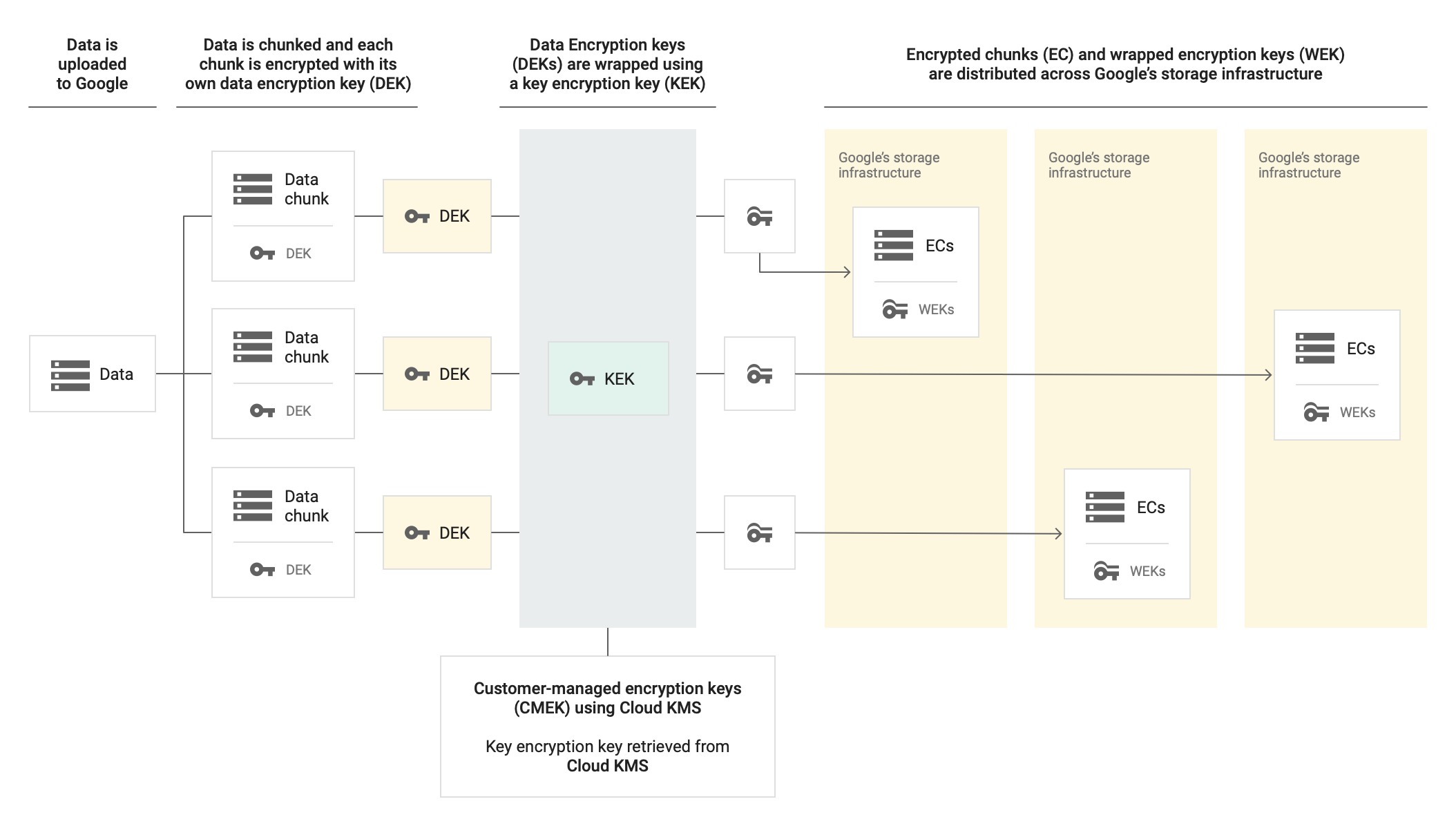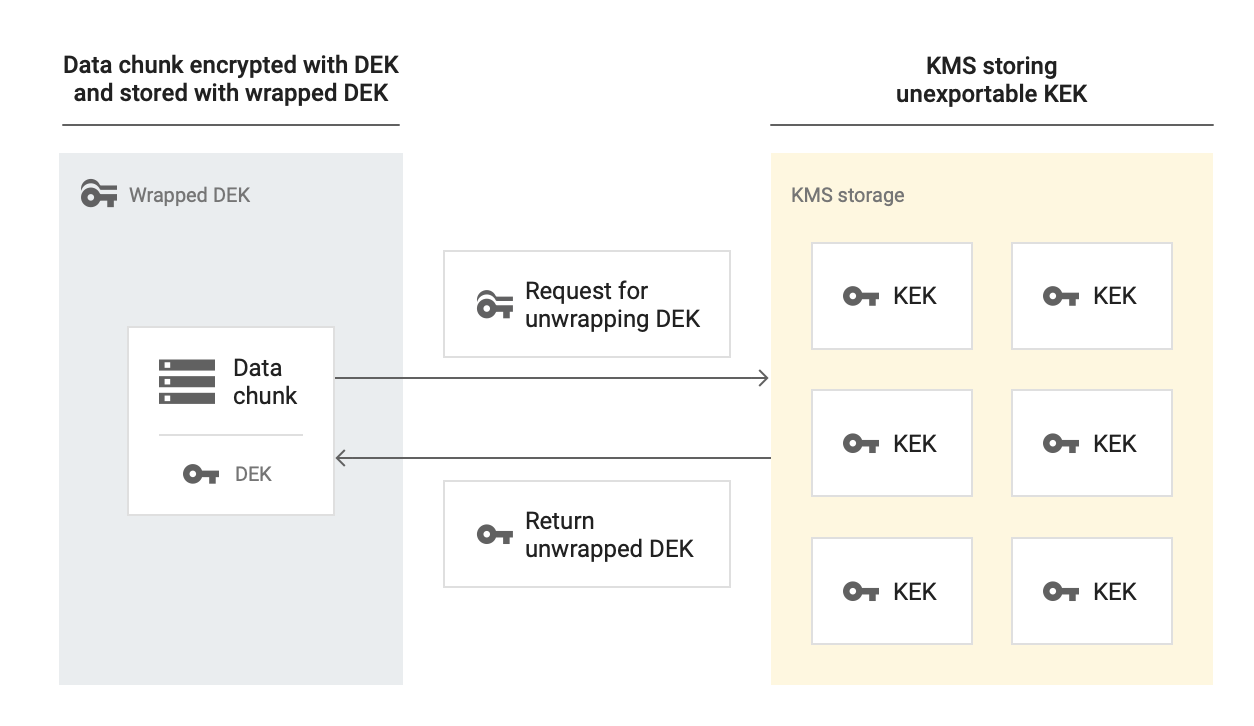By default, Cloud SQL for MySQL encrypts customer content at rest. Cloud SQL for MySQL handles encryption for you without any additional actions on your part. This option is called Google default encryption.
If you want to control your encryption keys, then you can use customer-managed encryption keys (CMEKs) in Cloud KMS with CMEK-integrated services including Cloud SQL for MySQL. Using Cloud KMS keys gives you control over their protection level, location, rotation schedule, usage and access permissions, and cryptographic boundaries. Using Cloud KMS also lets you track key usage, view audit logs, and control key lifecycles. Instead of Google owning and managing the symmetric key encryption keys (KEKs) that protect your data, you control and manage these keys in Cloud KMS.
After you set up your resources with CMEKs, the experience of accessing your Cloud SQL for MySQL resources is similar to using Google default encryption. For more information about your encryption options, see Customer-managed encryption keys (CMEK).
CMEK with Cloud KMS Autokey
You can either create CMEKs manually to protect your Cloud SQL for MySQL resources or use Cloud KMS Autokey. With Autokey, key rings and keys are generated on demand as part of resource creation in Cloud SQL for MySQL. Service agents that use the keys for encrypt and decrypt operations are created if they don't already exist and are granted the required Identity and Access Management (IAM) roles. For more information, see Autokey overview.
Autokey doesn't
create keys for Cloud SQL for MySQL BackupRun resources. When
you create a backup of a Cloud SQL for MySQL instance, the backup is
encrypted with the primary instance's customer-managed key.
Cloud SQL for MySQL is only compatible with Cloud KMS Autokey when creating resources using Terraform or the REST API.
To learn how to use manually-created CMEKs to protect your Cloud SQL for MySQL resources, see Use customer-managed encryption keys (CMEK).
To use CMEKs created by Cloud KMS Autokey to protect your Cloud SQL for MySQL resources, use the steps provided for Secret Manager at Using Autokey with Secret Manager resources as an example.
Google-managed encryption versus customer-managed encryption
The diagrams below show how data-at-rest encryption works inside a Cloud SQL instance when using default Google encryption versus customer-managed encryption keys.
Without CMEK

With CMEK

When decrypting data wrapped with customer-managed encryption keys, Cloud SQL uses the KEK to decrypt the DEK and the unencrypted DEK to decrypt data-at-rest.

When does Cloud SQL interact with CMEK keys?
| Operation | Notes |
| Instance creation | During instance creation, you configure the instance to use customer- managed encryption keys. |
| Backup creation | During backups for a CMEK-enabled instance, customer-managed encryption keys encrypt user data, such as user queries and responses. Backups from a CMEK-enabled instance inherit its encryption with same Cloud KMS key as the source instance. |
| Instance restore | During restores for a CMEK-enabled instance, Cloud SQL uses the key to access data on the backup instance being restored. When restoring to a different instance, the target instance can use a different key for encryption. |
| Replica creation | When you create a read or failover replica of a Cloud SQL instance in the same region, it inherits the CMEK from the parent instance. If you create a read or failover replica in a different region, you must select a CMEK from the other region. Each region uses its own set of keys. |
| Clone creation | Clones from a CMEK-enabled instance inherit CMEK encryption with same Cloud KMS key as the source instance. |
| Instance update | During updates to a CMEK-enabled instance, Cloud SQL checks the CMEK key. |
What locations support CMEK-enabled Cloud SQL instances?
CMEK is available in all Cloud SQL instance locations.
About service accounts
When your Cloud SQL instances have CMEK enabled, you need to use a service account to request key access from Cloud KMS.
To use a customer-managed encryption key on a project, you must have a service account and you must grant the customer-managed encryption key access to the service account. The service account must exist inside of the project. The service account is visible in all regions.
If you use the Console to create an instance, Cloud SQL automatically creates the service account when you first choose the Customer-managed key option (if a service account does not already exist). You don't need to have special permissions on your user account when Cloud SQL automatically creates the service account.
About keys
In Cloud KMS, you need to create a key ring with a cryptographic key, set with a location. When you create a new Cloud SQL instance, you select this key to encrypt the instance.
You need to know the key ID and key region when you create new Cloud SQL instances that use customer-managed encryption keys. You must put new Cloud SQL instances in the same region as the customer-managed encryption key associated with the instance. You can create one project for both keys and Cloud SQL instances, or different projects for each.
Customer-managed encryption keys use the following format:
projects/[KMS_PROJECT_ID]/locations/[LOCATION]/keyRings/[KEY_RING]/cryptoKeys/[KEY_NAME]
If Cloud SQL is unable to access the key (such as if you disable the key version), Cloud SQL suspends the instance. Once the key becomes accessible again, Cloud SQL automatically resumes the instance.
When you rotate keys, instances that are encrypted with that key aren't automatically re-encrypted with the new primary key version. You can re-encrypt any existing CMEK primary instance or replica with the new primary key version. For more information about how to re-encrypt a Cloud SQL instance or replica after a key rotation, see Re-encrypt an existing CMEK-enabled instance or replica.
External key managers
You can use keys stored in external key managers, such as Fortanix, Futurex, or Thales, as your customer-managed encryption keys. To learn how to use external keys with Cloud KMS, see Cloud External Key Manager (Cloud EKM).
Key Access Justifications
You can use Key Access Justifications as part of Cloud EKM. Key Access Justifications enable you to view the reason for each Cloud EKM request. Additionally, based on the justification provided, you can automatically approve or deny a request. To learn more, see the Key Access Justifications overview.
Thus, Key Access Justifications provides extra control over your data by providing a justification for each attempt to decrypt the data.
For related information about using your keys with Cloud SQL instances, see Creating a Cloud SQL instance with CMEK.
How do I make CMEK-encrypted data permanently inaccessible?
You might have situations where you want to permanently destroy data encrypted with CMEK. To do this, you destroy the customer-managed encryption key version. You can't destroy the key ring or key, but you can destroy key versions of the key.
How do I export and import data from and to a CMEK-enabled instance?
If you want your data to remain encrypted with a customer-managed key during an export or import, you must set a customer-managed encryption key on the Cloud Storage bucket before exporting data to it. There are no special requirements or restrictions to importing data to a new instance when the data was previously stored on an instance enabled with a customer-managed encryption key.
Restrictions
The following restrictions apply when using customer-managed encryption keys:
- You can't enable customer-managed encryption keys on an existing instance.
- You can't assign a different key to a replica in the same region as the primary instance. For cross-region replicas, you need to create a new key for the replica region.
- You can't assign a different key to a clone.
- You can't use customer-managed encryption keys to encrypt:
- External servers (external primary instances and external replicas)
- Instance metadata, such as the instance ID, database version, machine type, flags, backup schedule, etc.
- You can't use customer-managed encryption keys to encrypt user data in transit, such as user queries and responses.
- After you create a Cloud SQL instance, you can't change the encryption key type. You can't switch from a Google-owned and Google-managed encryption key to a Cloud Key Management Service (KMS) key, or the other way around.
What's next
- Learn about encryption at rest in Google Cloud Platform.
- Learn how to create an instance with CMEK enabled.
- Learn about Cloud Key Management Service (Cloud KMS).
- Learn about Quotas for Cloud KMS resources.
- Learn about IAM service accounts.
- Learn how to add key access justifications to your keys.
- Find other products that use CMEK.
